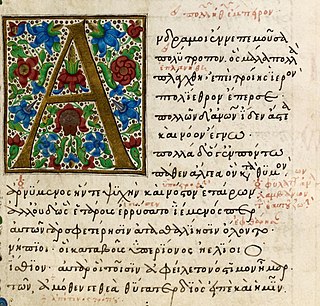
The Odyssey is one of two major ancient Greek epic poems attributed to Homer. It is one of the oldest extant works of literature still widely read by modern audiences. As with the Iliad, the poem is divided into 24 books. It follows the Greek hero Odysseus, king of Ithaca, and his journey home after the Trojan War. After the war, which lasted ten years, his journey lasted for ten additional years, during which time he encountered many perils and all his crew mates were killed. In his absence, Odysseus was assumed dead, and his wife Penelope and son Telemachus had to contend with a group of unruly suitors who were competing for Penelope's hand in marriage.

Odysseus, also known by the Latin variant Ulysses, is a legendary Greek king of Ithaca and the hero of Homer's epic poem the Odyssey. Odysseus also plays a key role in Homer's Iliad and other works in that same epic cycle.

Ithaca, Ithaki or Ithaka is a Greek island located in the Ionian Sea, off the northeast coast of Kefalonia and to the west of continental Greece.

Telemachus, in Greek mythology, is the son of Odysseus and Penelope, who is a central character in Homer's Odyssey. When Telemachus reached manhood, he visited Pylos and Sparta in search of his wandering father. On his return to Ithaca, he found that Odysseus had reached home before him.
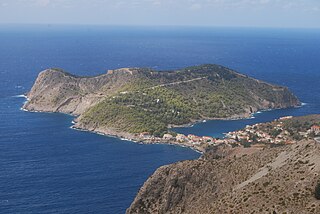
Kefalonia or Cephalonia, formerly also known as Kefallinia or Kephallenia (Κεφαλληνία), is the largest of the Ionian Islands in western Greece and the 6th largest island in Greece after Crete, Euboea, Lesbos, Rhodes and Chios. It is also a separate regional unit of the Ionian Islands region. It was a former Latin Catholic diocese Kefalonia–Zakynthos (Cefalonia–Zante) and short-lived titular see as just Kefalonia. The capital city of Cephalonia is Argostoli.

Scheria or Scherie, also known as Phaeacia or Faiakia was a region in Greek mythology, first mentioned in Homer's Odyssey as the home of the Phaeacians and the last destination of Odysseus in his 10-year journey before returning home to Ithaca. It is one of the earliest descriptions of a utopia.
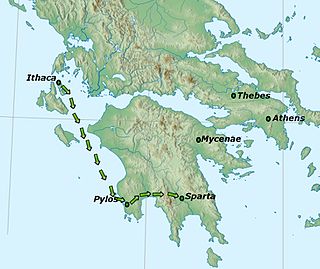
The Telemachy is a term traditionally applied to the first four books of Homer's epic poem the Odyssey. They are named so because, just as the Odyssey tells the story of Odysseus, they tell the story of Odysseus's son Telemachus as he journeys from home for the first time in search of news about his missing father.

Wilhelm Dörpfeld was a German architect and archaeologist, a pioneer of stratigraphic excavation and precise graphical documentation of archaeological projects. He is famous for his work on Bronze Age sites around the Mediterranean, such as Tiryns and Hisarlik, where he continued Heinrich Schliemann's excavations. Like Schliemann, Dörpfeld was an advocate of the historical reality of places mentioned in the works of Homer. While the details of his claims regarding locations mentioned in Homer's writings are not considered accurate by later archaeologists, his fundamental idea that they correspond to real places is accepted. Thus, his work greatly contributed to not only scientific techniques and study of these historically significant sites but also a renewed public interest in the culture and the mythology of Ancient Greece.
The Telegony is a lost ancient Greek epic poem about Telegonus, son of Odysseus by Circe. His name is indicative of his birth on Aeaea, far from Odysseus' home of Ithaca. It was part of the Epic Cycle of poems that recounted the myths of the Trojan War as well as the events that led up to and followed it. The story of the Telegony comes chronologically after that of the Odyssey and is the final episode in the Epic Cycle. The poem was sometimes attributed in antiquity to Cinaethon of Sparta, but in one source it is said to have been stolen from Musaeus by Eugamon or Eugammon of Cyrene. The poem comprised two books of verse in dactylic hexameter.

The Penelopiad is a novella by Canadian author Margaret Atwood. It was published in 2005 as part of the first set of books in the Canongate Myth Series where contemporary authors rewrite ancient myths. In The Penelopiad, Penelope reminisces on the events of the Odyssey, life in Hades, Odysseus, Helen of Troy, and her relationships with her parents. A Greek chorus of the twelve maids, who Odysseus believed were disloyal and whom Telemachus hanged, interrupt Penelope's narrative to express their view on events. The maids' interludes use a new genre each time, including a jump-rope rhyme, a lament, an idyll, a ballad, a lecture, a court trial and several types of songs.

Paliki is a peninsula and a former municipality on the island of Kefalonia, Ionian Islands, Greece. At the 2011 local government reform it became part of the municipality Kefalonia. In 2019 this municipality was divided into three municipalities, and the municipal unit Paliki became the only municipal unit of the new municipality Lixouri. The municipal unit has an area of 119.341 km2. The name comes from the ancient town of Pale/Pali, which was north of Lixouri and is now an archaeological site. The peninsula is the westernmost part of Kefalonia. The seat of the municipality was the town Lixouri (3,752).

Ithaca was, in Greek mythology, the island home of the hero Odysseus. The specific location of the island, as it was described in Homer's Odyssey, is a matter for debate. There have been various theories about its location. Modern Ithaca has traditionally been accepted to be Homer's island. One recent alternative candidate is Paliki, which may have been an island separated from the rest of Kefalonia, as argued by Bittlestone, Diggle and Underhill in Odysseus Unbound. This theory, however, has not been generally accepted on grounds of geology, archaeology, philology, or historical and Homeric analysis. “What is clearly missing,” wrote Dr Christine Haywood reviewing Odysseus Unbound, “is a good knowledge of the complexities of Homeric language, and the support of archaeology.”
Dulichium, also called Dolicha or Doliche, was a place noted by numerous ancient writers that was either a city on, or an island off, the Ionian Sea coast of Acarnania, Greece.
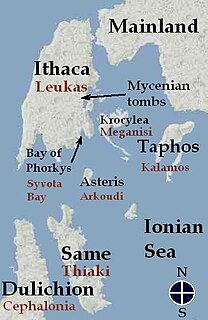
Same, also Samos (Σάμος) is an Ancient Greek name of a Homeric island in the Ionian Sea, near Ithaca and Cephalonia. In Homer's Odyssey Same is described as part of Odysseus's kingdom together with Ithaca, Dulichium, and Zacynthus. The Iliad, book II, in the Catalogue of Ships, contains a different list of islands comprising Odysseus's kingdom. Same is included together with Ithaca, Neritum, Krocylea, Aegilips and Zacynthus, indicating that the "Catalogue of Ships" could be a later addition to the Iliad.

Events in the main sequence of the Odyssey take place in the Peloponnese and in what are now called the Ionian Islands. Incidental mentions of Troy and its house, Phoenicia, Egypt, and Crete hint at geographical knowledge equal to, or perhaps slightly more extensive than that of the Iliad. However, scholars both ancient and modern are divided whether any of the places visited by Odysseus were real.
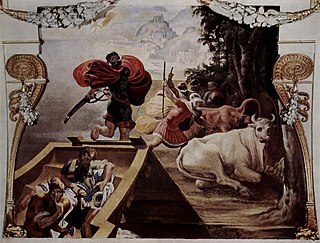
In Greek mythology, the Cattle of Helios, also called the Oxen of the Sun, are cattle pastured on the island of Thrinacia.
Agios Dimitrios is a village, about 2 miles (3.2 km) north of Lixouri in the Paliki peninsula of Cephalonia. The village which lies on the hillside just above the gulf of Argostoli and is a five-minute drive along the main road out of Lixouri.
The 1953 Ionian earthquake struck the southern Ionian Islands in Greece on August 12. In mid-August, there were over 113 recorded earthquakes in the region between Kefalonia and Zakynthos, and the most destructive was the August 12 earthquake. The event measured 6.8 on the moment magnitude scale, raised the whole island of Kefalonia by 60 cm (24 in), and caused widespread damage throughout the islands of Kefalonia and Zakynthos. The maximum felt intensity of shaking was X (extreme) on the Mercalli intensity scale. Between 445 and 800 people were killed.

In Greek mythology, the suitors of Penelope are one of the main subjects of Homer's Odyssey.
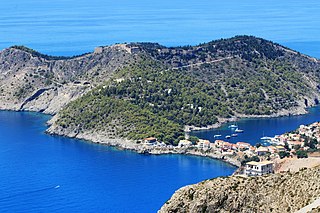
The Assos Castle is a Venetian fortification on Cephalonia island in western Greece.















